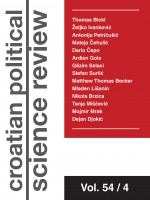Constitutional Design and Cultural Cleavage: UNESCO and the Struggle for Cultural Heritage in Kosovo
Constitutional Design and Cultural Cleavage: UNESCO and the Struggle for Cultural Heritage in Kosovo
Author(s): Stefan SurlićSubject(s): Cultural history, Diplomatic history, Political history, Government/Political systems, International relations/trade, Eastern Orthodoxy, Sociology of Religion
Published by: Fakultet političkih znanosti u Zagrebu
Keywords: Cultural Heritage; UNESCO; Kosovo; Serbian Orthodox Church; Post-Conflict Management;
Summary/Abstract: Since gaining independence in 2008, Kosovo’s constitutional design has been based on the principles of civil society normatively respecting the rights of all minorities. Even though no open conflict has taken place since 1999, except for individual interethnic incidents, Kosovo is still at the stage of post-conflict management. The Serbian community feels strongly attached to Serbia, while the Albanians do not want to give political autonomy to the Kosovo Serbs because they fear this could lead to a permanent division and eventual separatism. Based on research, the author pinpoints that a key cleavage is essentially the cultural one. The recent vote in the Assembly of UNESCO has intensified the hostile tone between Belgrade and Priština. Serbia considers Kosovo its Holy Land, the “Serbian Jerusalem”, due to a large number of Orthodox churches and monasteries found there, while the Albanian side believes that this cultural treasure inherently belongs to Kosovo and that the Orthodox monasteries were built on the foundations of Illyrian temples. This paper analyzes the imposed political dimension of cultural heritage with religious and mythological backgrounds. There is a great desire among the Kosovo authorities that it become a member of UNESCO, thereby reaffirming its international legal personality and stopping the efforts of the Serbs to have the Orthodox cultural heritage still listed as Serbian. The issue of cultural heritage has a direct impact on interethnic relations and contains the capacity to paralyze all other multiethnic institutions. The author analyzes the difference between the normative framework and the implementation of mechanisms for the protection of cultural heritage as well as the activities of Belgrade and Priština in the battle for ownership of cultural heritage.
Journal: Politička Misao
- Issue Year: LIV/2017
- Issue No: 04
- Page Range: 109-125
- Page Count: 17
- Language: English

